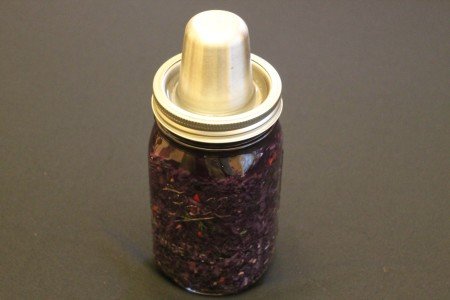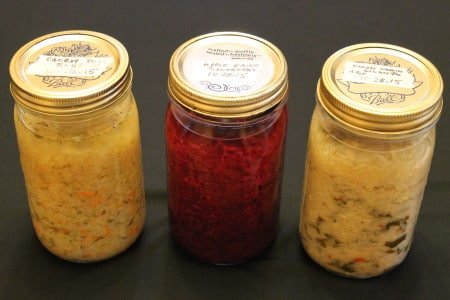Above is a picture of the purple sauerkraut I started a couple of days ago with cabbage, ginger, dill and hot pepper.
We had about ten cabbages of four different varieties in this year’s garden. Since we don’t have a great way to store them fresh for any length of time I went on a fermentation binge.
Three years ago when I made my first successful ferment I wrote about the method used here.
While that’s a perfectly fine method I was introduced to Kraut Source by an e-mail note from my daughter – she knows where my interests lay! They ‘kraut sourced’ their new ‘gizmo’ and I was intrigued. It has a spring-action top to keep the veggies submerged below the liquid and a moat ‘water filled’ top with a loose cone-shaped cover so the ferment burps itself. The only thing you need to do while the fermentation is doing its thing is to keep the moat filled with water which keeps the air out.
Here’s a picture of the three quarts I made a couple of weeks ago – fermented for ten days. From left to right: Dilly Kraut with Carrots, Purple Kraut with Apples, Raisins & Cinnamon and Kraut with Onion, Cilantro, Ginger, Cumin Seeds & Hot Pepper
Ferments can be done in as little as 4-5 days depending on how sour you like your kraut. Salt quantity can vary according to your taste. I used 2 teaspoons per quart.
The heat process involved in canning sauerkraut destroys the bacteria and probiotics that help digestion. We just refrigerate it when we deem it done.



Totally off subject but I was wondering if you ever eradicated the Texas Leaf-cutter ants that you fought. I’m trying everything and have a HUGE colony that I’m battling. Currently using Ant Block, the only thing recommended without luck. So far they have completely defoliated six crape myrtle trees (each 15 ft. tall), many many smaller bushes and are now working on a 40 ft. holly tree with gusto. I am finding it quite depressing to go out in my yard. I actually gave up on vegetables this year as a result of their damage.
confused…so, the heating process destroys the bacteria and probiotics? Is there a sauerkraut that is not heated?
Pardon my ignorance. I’ve never canned anything in my life.
Charles,
From what I’ve read, temperatures over 110 degrees F kill digestion friendly bacteria. The fermentation process, making sauerkraut, does not require heat. Canning at high heat is done after the fermentation to give the food indefinite shelf life. Bacteria friendly fermented products are available in the cooler section in many food stores.
Judy
Charles,
Yes, if you heat can/process (hot water bath, pressure, oven, etc) the ‘raw’ kraut it kills both the good and bad bacteria in it. You would do this if you need to store the kraut long term unrefrigerated. ‘Raw’ kraut can be stored in your refrigerator or freezer. Although I’m uncertain if the freezing destroys the good bacteria.
This is my second year making kraut, ~30 gallons this year, which I split with my friend that helps me make it and my uncle that provided some of the cabbage.
This year we packaged it all three ways, Raw, Heat processed and Frozen. Depending on how we are consuming it determines which we use.